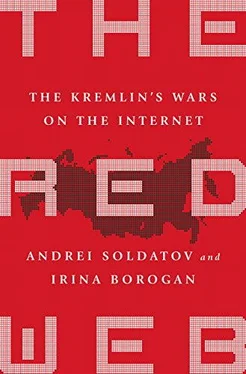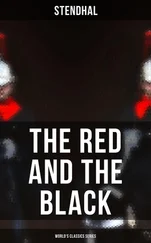Андрей Солдатов - The Red Web - The Struggle Between Russia's Digital Dictators and the New Online Revolutionaries
Здесь есть возможность читать онлайн «Андрей Солдатов - The Red Web - The Struggle Between Russia's Digital Dictators and the New Online Revolutionaries» весь текст электронной книги совершенно бесплатно (целиком полную версию без сокращений). В некоторых случаях можно слушать аудио, скачать через торрент в формате fb2 и присутствует краткое содержание. Город: New York, Год выпуска: 2017, ISBN: 2017, Издательство: PublicAffairs, Жанр: История, Политика, Интернет, Публицистика, на английском языке. Описание произведения, (предисловие) а так же отзывы посетителей доступны на портале библиотеки ЛибКат.
- Название:The Red Web: The Struggle Between Russia's Digital Dictators and the New Online Revolutionaries
- Автор:
- Издательство:PublicAffairs
- Жанр:
- Год:2017
- Город:New York
- ISBN:978-1-61039-57-3-1
- Рейтинг книги:3 / 5. Голосов: 1
-
Избранное:Добавить в избранное
- Отзывы:
-
Ваша оценка:
- 60
- 1
- 2
- 3
- 4
- 5
The Red Web: The Struggle Between Russia's Digital Dictators and the New Online Revolutionaries: краткое содержание, описание и аннотация
Предлагаем к чтению аннотацию, описание, краткое содержание или предисловие (зависит от того, что написал сам автор книги «The Red Web: The Struggle Between Russia's Digital Dictators and the New Online Revolutionaries»). Если вы не нашли необходимую информацию о книге — напишите в комментариях, мы постараемся отыскать её.
The Red Web: The Struggle Between Russia's Digital Dictators and the New Online Revolutionaries — читать онлайн бесплатно полную книгу (весь текст) целиком
Ниже представлен текст книги, разбитый по страницам. Система сохранения места последней прочитанной страницы, позволяет с удобством читать онлайн бесплатно книгу «The Red Web: The Struggle Between Russia's Digital Dictators and the New Online Revolutionaries», без необходимости каждый раз заново искать на чём Вы остановились. Поставьте закладку, и сможете в любой момент перейти на страницу, на которой закончили чтение.
Интервал:
Закладка:
The Guardian was among the first in the Western media to find itself in the Russian trolls’ crosshairs. On May 4 the newspaper reported that a particularly nasty strain emerged in the midst of the conflict in Ukraine, “which infests comment threads on the Guardian and elsewhere, despite the best efforts of moderators.” Readers and reporters became concerned that these comments came from “those paid to troll, and to denigrate in abusive terms anyone criticising Russia or President Vladimir Putin.” The first complaint to the moderators of the Guardian was reported on March 6, when a reader complained, “In the past weeks [I] have become incredibly frustrated and disillusioned by your inability to effectively police the waves of Nashibot trolls who’ve been relentlessly posting pro-Putin propaganda in the comments on Ukraine v Russia coverage.” The Guardian replied that there was no conclusive evidence about who was behind the trolling, although Guardian moderators, who deal with forty thousand comments a day, believed there was an orchestrated campaign. [8] Chris Elliot, “The Readers’ Editor On… Pro-Russia Trolling Below the Line on Ukraine Stories,” Guardian , May 4, 2014, www.theguardian.com/commentisfree/2014/may/04/pro-russia-trolls-ukraine-guardian-online .
In 2014 French and then Italian journalists told the authors that they were attacked by trolls when they published critical stories on Russia. In both countries the onslaughts were carried out in fluent and faultless French and Italian, and the trolls attacking the critical reporting from Russia were the same ones who separately were known to write xenophobic and anti-immigrant posts, which led French journalists to suspect that the comments could be coming from a community of far-right-wing activists.
In May, Ilya Klishin, the editor of the TV Dozhd website, shed some light on the trolls focused on the Western media. On May 21 Klishin exposed in Vedomosti the organization of trolls that had been directed to target the American audience. [9] Ilya Klishin, “Maksimalny retvit: Laiki na Zapad” [Maximus Retweet: Likes on the West], Vedomosti , May 21, 2014, www.vedomosti.ru/newspaper/articles/2014/05/21/lajki-na-zapad .
He reported that the team serving under Vyacheslav Volodin, the deputy chief of the presidential administration in Moscow, who had replaced Surkov at the peak of the 2012 protests, had proposed a “systematic manipulation of public opinion through social media.”
Sources close to the presidential administration told Klishin that preliminary work began in the fall of 2013 and that Volodin personally approved the strategy. Volodin also moved Konstantin Kostin—the Kremlin official who once had been on the other end of a phone line, pressuring the Yandex News team to shape their news report to fit Kremlin wishes—into a key position at the Civil Society Development Foundation, a pro-Kremlin organization, although Kostin remained directly subordinate to Volodin. [10] Konstantin Kostin’s interview to TV Dozhd, July 1, 2013, http://tvrain.ru/articles/eks_glava_upravlenija_vnutrennej_politiki_kremlja_konstantin_kostin_navalnomu_opasno_idti_na_vybory_karera_nemtsova_zakonchilas_na_vyborah_mera_sochi-346962/?video .
In the summer of 2013 he announced the launch of a new, large system for social network monitoring called “Mediaimpuls.”
It was an ambitious attempt to monitor and manipulate social networks. Kostin boasted that they joined efforts with the Boston-based firm Crimson Hexagon, using a system designed to figure out consumer trends on social networks. According to Kostin, Mediaimpuls could monitor LiveJournal and Twitter along with Russian social networks. But it was cursed with the same trouble the Russian secret services had been lamenting since 2011: it could not deal with Facebook because Facebook does not give up the data. [11] Ibid.
In the fall of 2013 the newspaper Novaya Gazeta exposed a “farm” of trolls writing away in a suburb of St. Petersburg known as Olgino. There the employees were paid over 25,000 rubles a month, then equivalent to about $900, to post comments on blogs and news articles. The troll farm occupied two rooms in a posh home with large glass walls. According to the report, employees in one room wrote blog posts for social networks, while those in the other room worked on comments. The troll farm had close ties with pro-Kremlin youth movements. Among those working in the glass-walled house was Katarina Aistova, the young woman mentioned above.
Anonymous International publicized the internal reports of this group in May 2014, with documents consisting of dozens of analytical briefs detailing the way the comments were dealt with on US media sites. There were also recommendations, such as this one for the site Politico: “In the future, there should be more provocative comments to start the discussion with the audience.”
The documents show that the masterminds of the troll movement were curious about legitimate online movements—the documents included, for example, a detailed analysis of Barack Obama support communities on Facebook and Twitter. They were also aware of the perils of being deleted by moderators; one brief cautions about “Censorship on the American Internet.” But the most interesting document was one that all but acknowledged that users in the United States could easily spot the troll campaigns supporting Russia, rendering the postings useless. “In the study of major US media, some pro-Russian comments were seen. After a detailed study, it became clear that such comments are extremely negatively perceived by the audience. In addition, users suggest that these comments were written either for ideological reasons or were paid.”
Although the campaign may not have worked well in the United States and Britain, Ukraine was different. False reports from the east of Ukraine and fake photographs of purported atrocities and victims flooded VKontakte and Facebook. Photographs of casualties from the war in Syria were doctored and presented as coming from the Ukraine provinces of Luhansk or Donetsk. The trolls claimed the violence was caused by Ukrainian “fascists” and sometimes borrowed images from war movies to make their point. There was a heart-wrenching photograph of a grieving young girl, sitting by the body of a dead woman sprawled on the ground and carrying the caption, “This is democracy, baby, Ukrainian army is killing Donbass people.” It went viral on social networks under the hashtag #SaveDonbassPeople. In fact, however, the photo was borrowed from a famous Russian film, Brest Fortress , released in 2010, about the Nazi invasion of the Soviet Union in 1941.
Although this and many other postings in the troll campaigns were filled with deceptions, they also struck a nerve, appealing to the historical memory of the Soviet Union—a country that lost over 30 million people in World War II—and carrying a highly emotional message to the Internet audience: fascists were coming again, this time with backing from the West, and there could be no questions asked, no place for skepticism, doubt, or opposition in this fight to the death.
By the end of 2014 the army of trolls enjoyed a major boost. The trolls at Olgino left the glass-walled house and moved to a four-story building in the same suburb of St. Petersburg in order to accommodate their growing numbers, now 250 people. [12] Anton Butsenko, “Trolli iz Olgino pereekhali v noviy chetyrekhatazhny office na Savushkina” [Trolls from Olgino Moved to a New Four-Story Office on Savushkina], DP.ru, October 28, 2014, www.dp.ru/a/2014/10/27/Borotsja_s_omerzeniem_mo .
They worked in twelve-hour shifts and were required to post 135 comments a day. [13] Dmitry Volchek and Daisy Sindelar, “One Professional Russian Troll Tells All,” Radio Free Europe/Radio Liberty, March 27, 2015, www.rferl.org/content/how-to-guid-russian-trolling-trolls/26919999.html .
New initiatives were launched, such as a quasi-news agency, like ANNA News, which was registered in Abkhazia, a breakaway region of Georgia. The agency set up accounts on a Russian replica of YouTube, known as Rutube; on YouTube itself; and on VKontakte, Facebook, Twitter, Google+, and Odnoklassniki. They posted videos that were presented as news but were largely propagandistic, including videos celebrating fighting by separatists in Ukraine. Another faux news agency, Novorossia television, set up accounts in social networks, posted videos on a daily basis, and collected money for separatists. The videos were then picked up by conventional pro-Kremlin TV channels and disseminated domestically and internationally. The efforts of these fake news agencies were combined with those of dozens of online communities positioned as blogs of patriotic citizens.
Интервал:
Закладка:
Похожие книги на «The Red Web: The Struggle Between Russia's Digital Dictators and the New Online Revolutionaries»
Представляем Вашему вниманию похожие книги на «The Red Web: The Struggle Between Russia's Digital Dictators and the New Online Revolutionaries» списком для выбора. Мы отобрали схожую по названию и смыслу литературу в надежде предоставить читателям больше вариантов отыскать новые, интересные, ещё непрочитанные произведения.
Обсуждение, отзывы о книге «The Red Web: The Struggle Between Russia's Digital Dictators and the New Online Revolutionaries» и просто собственные мнения читателей. Оставьте ваши комментарии, напишите, что Вы думаете о произведении, его смысле или главных героях. Укажите что конкретно понравилось, а что нет, и почему Вы так считаете.












